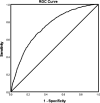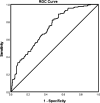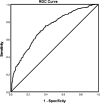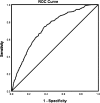Risk Factors Associated With Exclusion of Obese Patients Ischemic Stroke With a History of Smoking From Thrombolysis Therapy
- PMID: 38600881
- PMCID: PMC11010763
- DOI: 10.1177/10760296241246264
Risk Factors Associated With Exclusion of Obese Patients Ischemic Stroke With a History of Smoking From Thrombolysis Therapy
Abstract
The objective of this study is to determine risk factors that may contribute to exclusion decision from recombinant tissue plasminogen activator (rtPA) in patients with acute ischemic stroke (AIS) with a combined current or history of smoking and obesity. This study was conducted on data from 5469 patients with AIS collected from a regional stroke registry. Risk factors associated with inclusion or exclusion from rtPA were determined using multivariate logistic regression analysis. The adjusted odds ratios and 95% confidence interval for each risk factor were used to predict the increasing odds of an association of a specific risk factor with exclusion from rtPA. In the adjusted analysis, obese patients with AIS with a history of smoking (current and previous) excluded from rtPA were more likely to present with carotid artery stenosis (OR = 0.069, 95% CI 0.011-0.442), diabetes (OR = 0.604, 95% CI 0.366-0.997), higher total cholesterol (OR = 0.975, 95% CI 0.956-0.995), and history of alcohol use (OR = 0.438, 95% CI 0.232-0.828). Higher NIHSS score (OR = 1.051, 95% CI 1.017-1.086), higher triglycerides (OR = 1.004, 95% CI 1.001-1.006), and higher high-density lipoprotein (OR = 1.028, 95% CI 1.000-1.057) were associated with the inclusion for rtPA. Our findings reveal specific risk factors that contribute to the exclusion of patients with AIS with a combined effect of smoking and obesity from rtPA. These findings suggest the need to develop management strategies to improve the use of rtPA for obese patients with AIS with a history of smoking.
Keywords: acute ischemic stroke; obesity; risk factors; rtPA; smoking.
Conflict of interest statement
Declaration of Conflicting InterestsThe authors declared no potential conflicts of interest with respect to the research, authorship, and/or publication of this article.
Figures




Similar articles
-
Acute Ischemic Stroke and Heart Failure: Stroke Risk Factors Associated with Exclusion from Thrombolytic Therapy.Clin Appl Thromb Hemost. 2022 Jan-Dec;28:10760296221116347. doi: 10.1177/10760296221116347. Clin Appl Thromb Hemost. 2022. PMID: 36278505 Free PMC article.
-
Cholesterol reducer and thrombolytic therapy in acute ischemic stroke patients.Lipids Health Dis. 2020 May 6;19(1):84. doi: 10.1186/s12944-020-01270-2. Lipids Health Dis. 2020. PMID: 32375780 Free PMC article.
-
Gender and thrombolysis therapy in acute ischemic stroke patients with incidence of obesity.Neurol Sci. 2019 Sep;40(9):1829-1839. doi: 10.1007/s10072-019-03902-7. Epub 2019 May 2. Neurol Sci. 2019. PMID: 31049791
-
Thrombolytic therapy within 3 to 6 hours after onset of ischemic stroke: useful or harmful?Stroke. 2002 May;33(5):1437-41. doi: 10.1161/01.str.0000015555.21285.db. Stroke. 2002. PMID: 11988629 Review.
-
Stent Retrievers for the Treatment of Acute Ischemic Stroke: A Systematic Review and Meta-analysis of Randomized Clinical Trials.JAMA Neurol. 2016 Mar;73(3):275-81. doi: 10.1001/jamaneurol.2015.4441. JAMA Neurol. 2016. PMID: 26810499 Review.
References
-
- Azarpazhooh MR, Etemadi MM, Donnan GA, et al. Excessive incidence of stroke in Iran: evidence from the Mashhad Stroke Incidence Study (MSIS), a population-based study of stroke in the Middle East. Stroke. 2010;41(1):e3-e10. - PubMed
MeSH terms
Substances
Grants and funding
LinkOut - more resources
Full Text Sources
Medical

